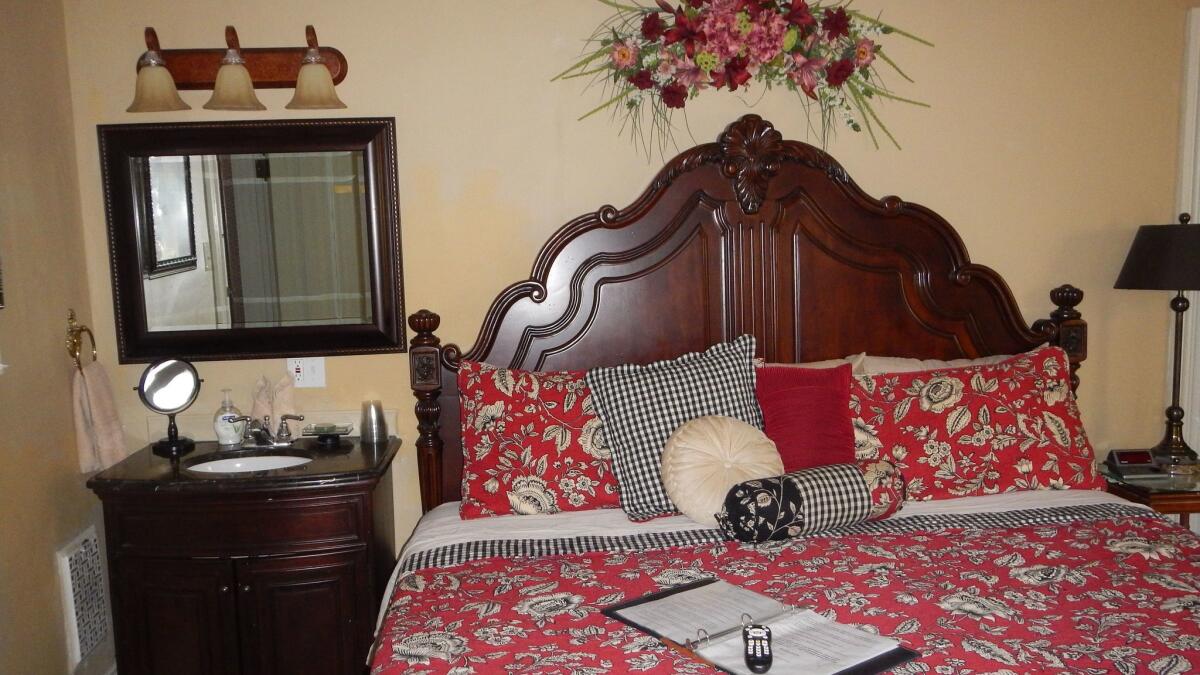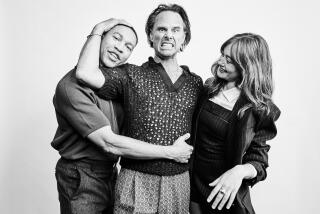Britain’s darkest hour is Missouri town’s finest as films once again push Churchill to the fore

- Share via
Reporting from Fulton, Mo. — In an early scene in the movie “Darkest Hour,” Winston Churchill’s family gathers to toast him for his recent appointment as Britain’s prime minister.
The camera briefly captures Churchill’s five children, including his youngest daughter, Mary, who grew up to become Lady Soames.
Thoughts of Lady Soames and her famous father filled my head in October as I fell asleep in my room at the Loganberry Inn in Fulton, Mo., just after I had seen the Midwest premiere of “Darkest Hour,” starring Gary Oldman as Churchill.
A bumper crop of Churchill
Gary Oldman’s performance “gives us a sense of a flesh-and-blood person behind the bulldog-fierce political leader who presided over his country’s celebrated World War II resistance,” Los Angeles Times film critic Kenneth Turan wrote in his review.
Oldman won the Golden Globe on Sunday for his performance and has been nominated for a Screen Actors Guild Award; that ceremony is Jan. 21. His performance also has garnered Oscar buzz. The Academy Award nominations will be announced Jan. 23.
“Churchill,” starring Brian Cox, was released in June. In an article about overlooked films of the year, Gary Goldstein writes that “Cox’s towering turn as the iconic British prime minister was easily on par with Gary Oldman’s performance.”
And Churchill also played a role in “Dunkirk.” His “we-shall -never-surrender” speech is read aloud at the end of the movie about the rescue of more than 300,000 British Expeditionary Forces and Allied troops from the town in northern France.
Where is Fulton?

Before her death in 2014, Lady Soames enjoyed the same pleasant yet humble accommodations as I, as has her niece, Edwina Sandys, Winston Churchill’s granddaughter.
It takes a little effort to find Fulton on a map. The town of fewer than 13,000 residents in east-central Missouri is about an hour west of St. Louis. It’s not on the Missouri River or on Interstate 70; it’s really in the middle of nowhere.
Churchill came to Fulton on March 5, 1946, when he gave a speech first identifying the “Iron Curtain” that had descended on Eastern Europe. The talk was titled “Sinews of Peace,” but is now recognized historically as “The Iron Curtain Speech.”
Why did Churchill come to Fulton and why, more than 70 years later, was a major motion picture premiering in this Midwestern town?
Why Fulton?
Fulton is home to two highly rated private colleges: William Woods University and Westminster College, which has fewer than 1,000 students.
In the 1930s, the family of one of Westminster’s graduates endowed a fund to bring speakers of “international significance” to campus. In 1946, at the behest of Missouri native President Truman, Churchill’s good friend, Churchill accepted the invitation to speak here.
It was a big deal for a rural Missouri town in 1946, less than a year after the end of the war, which came about in no small part because of Churchill’s resolve.
Up from the ashes
Twenty years later, the Westminster faculty decided it was time to commemorate Churchill’s visit. A Life magazine article featured several beautiful London churches that remained in ruins more than two decades after the Blitz.
Fulton’s residents decided to buy one of the churches, pack up the rubble, sail it across the ocean, settle it in Missouri and build a monument to Churchill.
They chose the Church of St. Mary the Virgin, Aldermanbury, designed in the 1600s by Christopher Wren — it was one of 53 London churches he designed, including St. Paul’s.
Shakespeare may have worshiped here, and “Paradise Lost” author John Milton was married here.
Luminaries who have visited here
The church is a focal point of the National Churchill Museum, the most comprehensive facility devoted to Churchill outside London.
That’s why Lady Soames came to Fulton and stayed at the Loganberry Inn just a block from the museum devoted to her father’s legacy.
Sandys, her niece, has been here many times. She is the artist responsible for nabbing eight sections of the Berlin Wall when it came down, turned it into a sculpture called “Breakthrough.” It now graces the front lawn of the reconstructed church.
Mikhail Gorbachev, onetime president of the Soviet Union, took time to admire the sculpture during his visit in 1992, along with President Reagan. Lech Walesa, formerly Poland’s president, surely paused here for a few minutes before his speech at Westminster. He slept in the room next to mine at the Loganberry.
The list of luminaries goes on. Presidents Ford and George H.W. Bush and leading figures from Korea, Israel, the Philippines, Italy, Belgium and France have visited Fulton. British Prime Minister Margaret Thatcher, who died in 2013, had her own room at the Loganberry.
No world leaders attended the premiere of “Darkest Hour.” Neither did Oldman.
But you just never know who is going to show up in this little town in the middle of Missouri.
Info: National Churchill Museum, 501 Westminster Ave., Fulton. Admission: $8.50 for adults, $7.50 for seniors 65 and older, $6.50 for those 12-18 and for college students, $5.50 for those 6-11 and free for those 5 and younger.
ALSO:
Now you can ride a driverless shuttle in Las Vegas for free
What I did wrong in 2017, and my 6 resolutions for being a better traveler in 2018
Crested Butte, Colo., brims with outdoor winter adventures
More to Read
Sign up for The Wild
We’ll help you find the best places to hike, bike and run, as well as the perfect silent spots for meditation and yoga.
You may occasionally receive promotional content from the Los Angeles Times.






